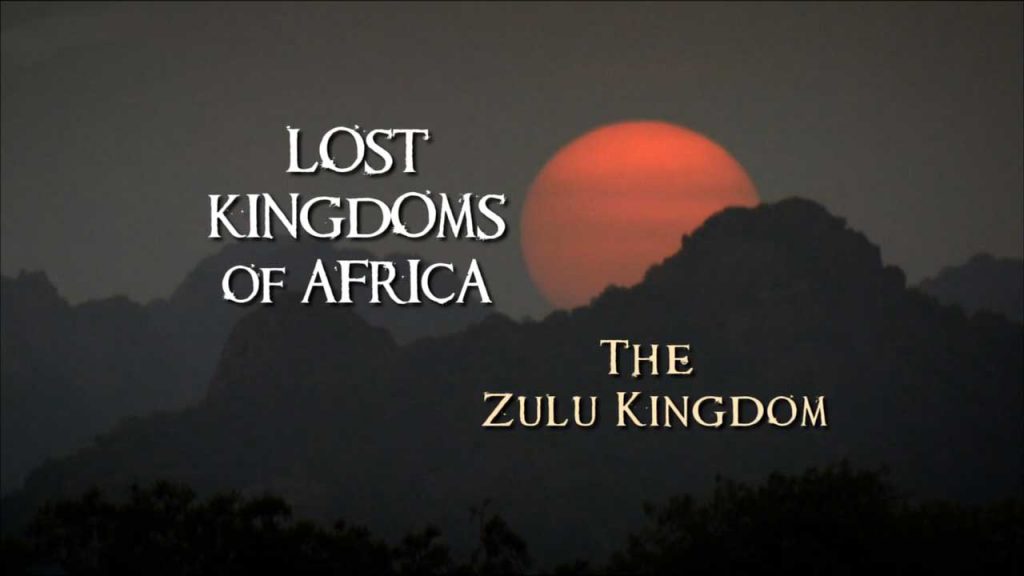Lost Kingdoms of Africa episode 6 – The Zulu Kingdom: In South Africa, Gus Casely-Hayford visits evocative sites in Zulu history and searches for the secrets behind the Zulu’s cultural power and military strength.
We know less about Africa’s distant past than almost anywhere else on Earth. But the scarcity of written records doesn’t mean that Africa lacks history – it is found instead in the culture, artefacts and traditions of the people. In this series, art historian Dr Gus Casely-Hayford explores some of the richest and most vibrant histories in the world, revealing fascinating stories of four complex and sophisticated civilisations: the Kingdom of Asante, the Zulu Kingdom, the Berber Kingdom of Morocco and the Kingdoms of Bunyoro & Buganda.
In this episode, Dr Casely-Hayford travels to South Africa to explore the history of one of Africa’s most famous kingdoms. Visiting some of the most evocative sites in Zulu history, he examines the origins of the Zulu in the 17th century, their expansion under controversial military leader King Shaka and their brutal encounters with the Boers and the British. He also searches for the secrets behind the Zulu’s cultural power and legendary military strength, and why Zulu identity continues to endure.
Lost Kingdoms of Africa episode 6 – The Zulu Kingdom
The Zulu Kingdom (/zuːluː/, Zulu: KwaZulu), sometimes referred to as the Zulu Empire or the Kingdom of Zululand, was a monarchy in Southern Africa that extended along the coast of the Indian Ocean from the Tugela River in the south to Pongola River in the north.
The kingdom grew to dominate much of what is today KwaZulu-Natal and Southern Africa. In 1879, the British Empire invaded, beginning the Anglo-Zulu War. After an initial Zulu victory at the Battle of Isandlwana in January, the British Army regrouped and defeated the Zulus in July during the Battle of Ulundi. The area was absorbed into the Colony of Natal and later became part of the Union of South Africa.
Before encountering the British, the Zulus were first confronted with the Boers. In an attempt to form their own state as a protection against the British, the Boers began moving across the Orange River northwards. While travelling they first collided with the Ndebele kingdom, and then with Dingane’s Zulu kingdom.
In October 1837, the Voortrekker leader Piet Retief visited Dingane at his royal kraal to negotiate a land deal for the voortrekkers. In November, about 1,000 Voortrekker wagons began descending the Drakensberg mountains from the Orange Free State into what is now KwaZulu-Natal.
Dingane asked that Retief and his party retrieve some cattle stolen from him by a local chief as part of the treaty for land for the Boers. This Retief and his men did, returning on 3 February 1838. The next day, a treaty was signed, wherein Dingane ceded all the land south of the Tugela River to the Mzimvubu River to the Voortrekkers. Celebrations followed. On 6 February, at the end of the celebrations, Retief’s party were invited to a dance, and asked to leave their weapons behind. At the peak of the dance, Dingane leapt to his feet and yelled “Bambani abathakathi!” (isiZulu for “Seize the wizards”). Retief and his men were overpowered, taken to the nearby hill kwaMatiwane, and executed. Some allege that they were killed for withholding some of the cattle they recovered, but it is likely that the deal was a plot to overpower the Voortrekkers. Dingane’s army then attacked and massacred a group of 250 Voortrekker men, women and children camped nearby. The site of this massacre is today called Weenen, (Dutch for “to weep”).
The remaining Voortrekkers elected a new leader, Andries Pretorius, who led a crushing attack on the Zulu forces and Dingane at the Battle of Blood River on 16 December 1838, when 15,000 Zulu impis (warriors) attacked a group of 470 Voortrekker settlers led by Pretorius.




